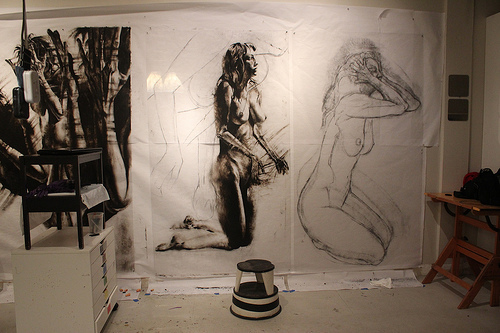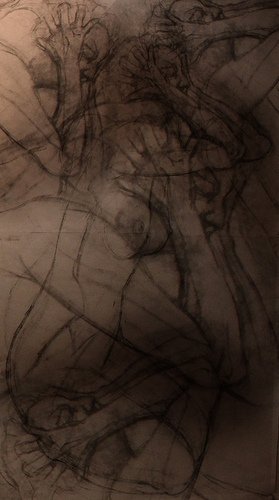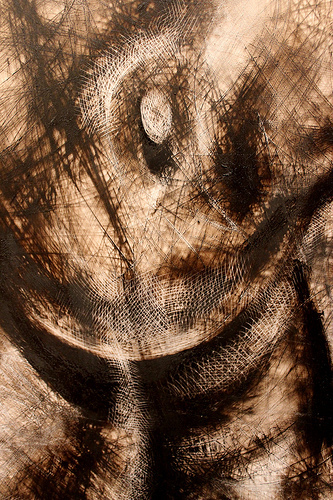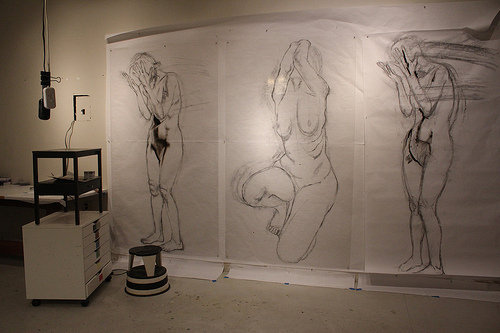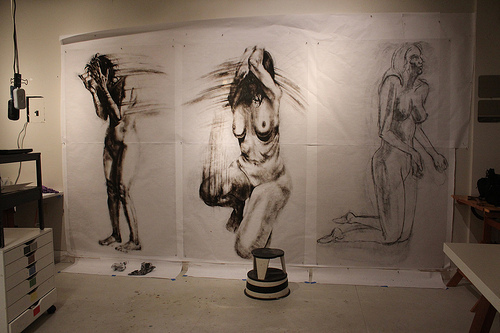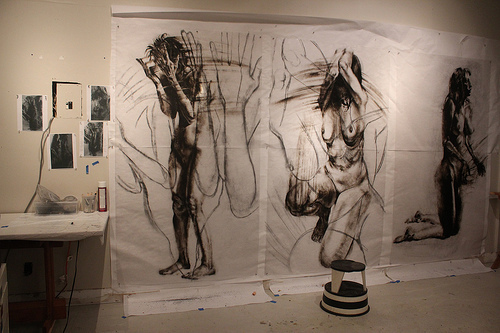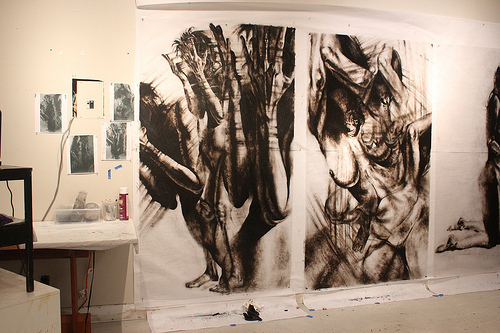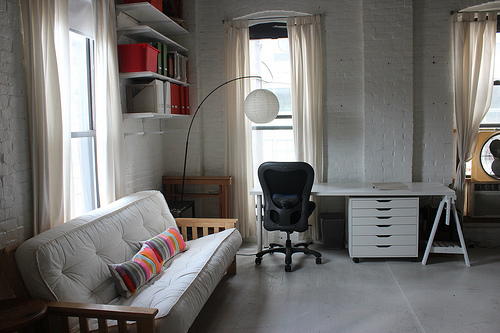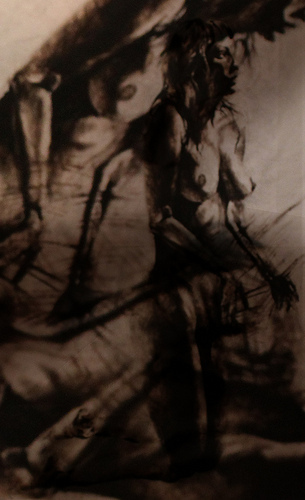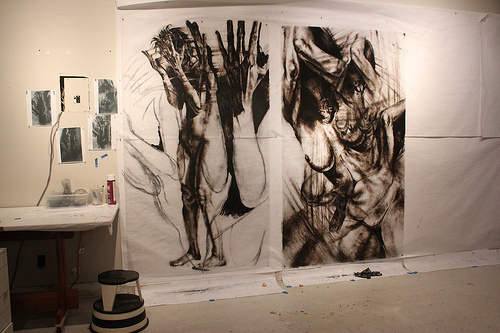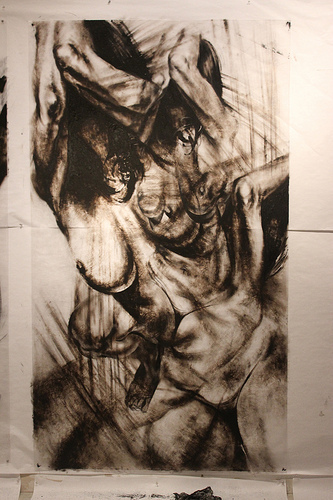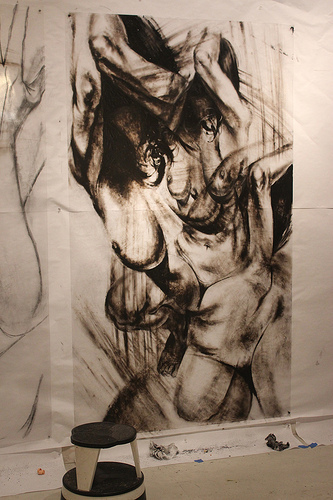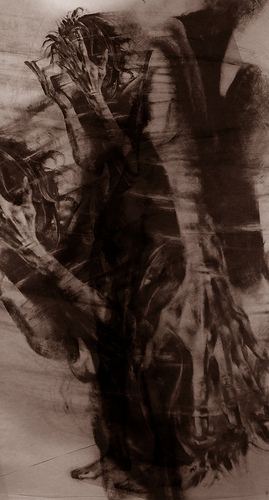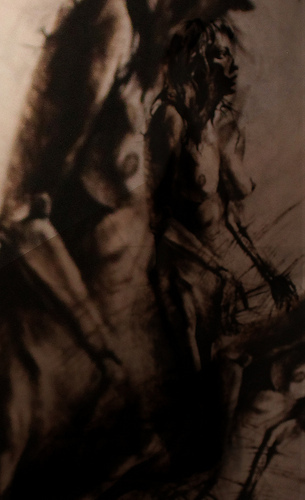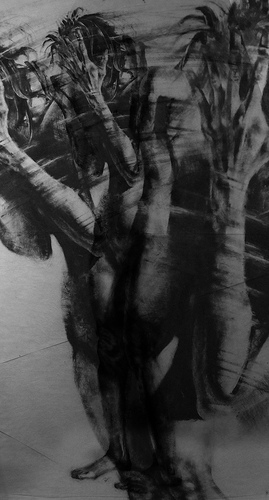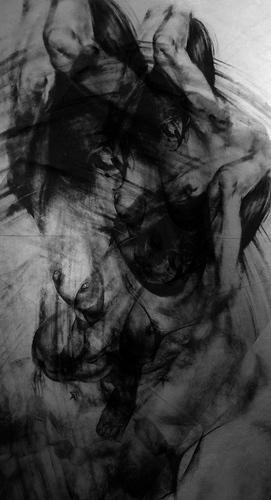Clara Lieu's Blog, page 43
October 13, 2013
Fourth drawing
I finished up one of the drawings, so I was able to get started on the sketching of a fourth drawing today. Because the etching ink takes so long to dry (about 5 days) I always have to make sure that I have multiple drawings going at different stages so that I always have something to work on. On top of that, the cross-hatching with the x-acto knife is tough on my hands, so I have to spread out that task as much as possible.
I figured since I had the fourth drawing sketched out in vine charcoal that I could jump right into the digital sketches. I think I like the idea of doing the digital sketches from the vine charcoal sketch, they’re a little easier to read.
I’ve also been working a lot on cross-hatching with the x-acto knife over the past few days. You can’t see the hatching at all in the photographs, so I shot a detail image below where you can see the cross-hatched marks more clearly.


October 12, 2013
Thriving
I went to the studio for about two hours last night, despite having taught all day at RISD. My day started at 6:30am, I got home from teaching at 6pm, ate dinner, and then was in the studio until 10:30pm. A long day, but I was so excited to be in the studio that I didn’t care about how tired I was. My initial goal was to get to the studio three times a week, but that doesn’t seem to be enough, and on nights that I don’t go I feel like I’m going through withdrawal. I’m really aiming to get there every day now because I love being there so much. I’ve been blowing off chores at night, and my house is going to hell, but my artwork is alive and thriving!
It’s been interesting to me to watch the progression of these drawings, they really have come such a long way from where they began a few weeks ago.


October 11, 2013
12 ways to prepare for open studios
I’m having a blast gearing up for Waltham Mills Open Studios, which is Nov. 2-3. When I was a recent graduate I used to participate in Jamaica Plain Open Studios annually, and it was always such a great experience. Back then I didn’t have my own studio space so I always showed at one of the group venues and had to schlep my work there every time. This time will be completely different, since I have my own space that I can present in.
I was thinking today that it might be helpful to other artists to have a list of recommendations for open studios events. Below are some practical suggestions when getting ready for an open studios event.
1)Have a range of prices. Most visitors at open studios purchase art in the $10-$50 range, with most purchases averaging about $20 each. This strategy works well, as you can make money on volume. The most expensive piece I ever sold at open studios was a $90 drawing. I make sure that I show about 3-5 of my very large pieces (ones that are in the $1,000-$2,000 range) to draw people into the space, and then provide small works that can be impulse buys. People love being able to bring something small home with them.
2)Have a diverse and large quantity of art. One of your goals at open studios is to get your visitors to linger in your studio. The more you have for visitors to look at, the longer they will stay. Variety is important too, if everything you make looks the same, it won’t matter how much art you have. This year I’ll be showing drawings, digital prints, and beeswax and white resin sculptures. (see photo below)
3)Play an ongoing slideshow on your laptop. I have so much art that there’s just no chance people will see it all, so a slideshow is an effective way to represent the scope of your work.
4)Have free postcards. People love free stuff, and they enjoy collecting postcards as they wander through the studios. Be sure to have your contact information and website on the back of the postcard.
5)Make sure prices are displayed. Most people don’t like to bother to ask the artist what the price is of a work. Having the prices clearly marked in a tasteful way makes things more accessible to your visitors.
6)Have a binder with articles, your resume, and artist statement. This gives you credibility so that your visitors can find out more about you, without having to ask you directly. It makes you look professional and accomplished. People love reading about artists. The more information, the better.
7)Have a guestbook. I’ve had people write lovely comments to me in guestbooks, it’s just another way to get people interacting with your studio. Some people are very shy and won’t want to speak to you in person, so this provides another way for them to communicate with you.
8)Have an email list. Let people sign their email addresses so you can add them to your mailing list. I personally don’t bother with mailing hard copy postcards anymore; I save those for the art dealers and curators because it’s so costly. Everyone else gets digital announcements now.
9)Package the art properly. Invest the money in neat plastic sleeves to place your artwork into. This achieves two things: practically speaking people can handle the artwork without ruining it, and the work will look clean and professional.
10)Have music and food. This provides a fun and relaxed atmosphere to your studio, and can help fill in awkward silence when there are just a few people in the studio. Keep the food minimal, some wrapped candy tends to work well. People with kids will especially appreciate it.
11)Wear a name tag. Yes, it’s really dorky, but it will help people identify who you are, especially when it gets crowded.
12)Make sure all of your work is signed. People who buy art really want to have signed work. As an artist, it’s frequently the last thing on my mind when I’m making the work, so I always make sure I go through all of the work and sign it.


10 ways to prepare for open studios
I’m having a blast gearing up for Waltham Mills Open Studios, which is Nov. 2-3. When I was a recent graduate I used to participate in Jamaica Plain Open Studios annually, and it was always such a great experience. Back then I didn’t have my own studio space so I always showed at one of the group venues and had to schlep my work there every time. This time will be completely different, since I have my own space that I can present in.
I was thinking today that it might be helpful to other artists to have a list of recommendations for open studios events. Below are some practical suggestions when getting ready for an open studios event.
1)Have a range of prices. Most visitors at open studios purchase art in the $10-$50 range, with most purchases averaging about $20 each. This strategy works well, as you can make money on volume. The most expensive piece I ever sold at open studios was a $90 drawing. I make sure that I show about 3-5 of my very large pieces (ones that are in the $1,000-$2,000 range) to draw people into the space, and then provide small works that can be impulse buys. People love being able to bring something small home with them.
2)Have a diverse and large quantity of art. One of your goals at open studios is to get your visitors to linger in your studio. The more you have for visitors to look at, the longer they will stay. Variety is important too, if everything you make looks the same, it won’t matter how much art you have. This year I’ll be showing drawings, digital prints, and beeswax and white resin sculptures. (see photo below)
3)Play an ongoing slideshow on your laptop. I have so much art that there’s just no chance people will see it all, so a slideshow is an effective way to represent the scope of your work.
4)Have free postcards. People love free stuff, and they enjoy collecting postcards as they wander through the studios. Be sure to have your contact information and website on the back of the postcard.
5)Make sure prices are displayed. Most people don’t like to bother to ask the artist what the price is of a work. Having the prices clearly marked in a tasteful way makes things more accessible to your visitors.
6)Have a binder with articles, your resume, and artist statement. This gives you credibility so that your visitors can find out more about you, without having to ask you directly. It makes you look professional and accomplished. People love reading about artists. The more information, the better.
7)Have a guestbook. I’ve had people write lovely comments to me in guestbooks, it’s just another way to get people interacting with your studio. Some people are very shy and won’t want to speak to you in person, so this provides another way for them to communicate with you.
8)Have an email list. Let people sign their email addresses so you can add them to your mailing list. I personally don’t bother with mailing hard copy postcards anymore; I save those for the art dealers and curators because it’s so costly. Everyone else gets digital announcements now.
9)Package the art properly. Invest the money in neat plastic sleeves to place your artwork into. This achieves two things: practically speaking people can handle the artwork without ruining it, and the work will look clean and professional.
10)Have music and food. This provides a fun and relaxed atmosphere to your studio, and can help fill in awkward silence when there are just a few people in the studio. Keep the food minimal, some wrapped candy tends to work well. People with kids will especially appreciate it.


October 10, 2013
Transparency
I was able to finish up the majority of the etching ink work on the first two drawings last night, which felt great. To critique myself, I think that the drawing on the left lacks the sense of transparency that is present on the drawing on the right. I’m hoping to fix that after the etching ink dries and I’m able to go back into the drawing with an x-acto knife and lithographic crayon.
I’m the most excited about the compositions right now, and how complex and layered they’re becoming. It feels terrific to make compositions like this after working only with the human face for so long. I just hope the intensity of emotion is coming through. I do worry that I’m getting too caught up making engaging compositions and losing track of the emotion.
In the mean time, I’m trying to work on a digital sketch for the third drawing. This figure has been giving me a lot of trouble because the pose itself is very vertical and doesn’t have any diagonal movement to it. There is a ton of negative space on the left hand side that really needs to get broken up for this composition to come together. In composing this piece, I’m trying to focus on the arms, as they are the most dynamic part of the pose and therefore offers the most possibilities.


October 9, 2013
Ask the Art Professor: Six Ways to Confront Artist’s Block
I’ve written about artist’s block before, here’sa revised version that is featured in the Huffington Post today.
“How do you face artistic burnout or times of no motivation?”
Two years ago, I went through the worst creative crisis of my career so far. I was starting a new series of face sculptures, the second stage of a long term project called “Falling”, which explored my personal experience with depression and anxiety. I was so certain that I wanted to do something with sculpture, but nothing seemed to be working. All I could do was glare at the plaster sculptures I had made so far with the sinking feeling that something was terribly wrong.

I hated weeks worth of work. The lack of passion I was feeling was troubling and unsettling. I had never experienced such a profound loss of interest in my work before. I desperately wanted so badly to slap myself back into shape, but that desire only heightened my frustration. Alarmed and distraught, everything came to a horrible standstill.
Not wanting to waste any more costly art supplies, I dropped everything and stopped working altogether. This is the kiss of death for an artist. Instead, I just let myself think and write. In the meantime, I reached out to my friends, colleagues, and blog readers. In doing so, I was able to fabricate a series of strategies for how to get myself out of my rut.
1) Reach out to your artist friends and mentors.
This is one of the most effective strategies for staying sane if you’re having a rough time. Talk to your friends who are artists, explain to them what’s happening with your work. If you have a mentor, call them up and whine your heart out. Your artist friends and mentors will provide the support and encouragement that is so critical to have when things aren’t going well. Try not to have a pity party for yourself and wallow in despair on your own. None of that is productive and will only allow you to sink deeper into destructive emotions.
2) Suspend your inner critic.
We are our own toughest critics. We are significantly more demanding of ourselves than anyone else. Throw out your ambition and expectations temporarily, knowing that when you’re ready, you will reinstate them.
3) Change your environment.
Taking a short trip can sometimes break up the monotony of your regular environment, and can often times stimulate some sorely needed inspiration. A weekend in New York City almost always works for me. Even spending a whole day in a local museum can be incredibly refreshing and allow you to reset your brain.
4) Change media.
Switching to a different material can provide a different perspective on the same subject. It can keep your hands busy and get you thinking about your work in different ways. For example, if you’re working with two-dimensional media, change to three-dimensional media and see how that transforms your outlook.
5) Take a break.
Hit the gym, read a good book, pig out at a good restaurant, whatever works for you. This will provide both the physical and emotional distance and time away from your work that you need. Many of us will hit a creative plateau with our work: we know that we need to change something, but we don’t know what because we’ve been staring at the work for too long. Getting away from the piece will allow you to see the work with fresh eyes when you return.
6) Don’t give up.
One of my friends said this to me when I was in complete despair, and it was exactly the kind of straightforward, no-nonsense advice that I needed to hear at the time. Know that as much as it hurts when you’re in the thick of it, that this too, shall pass. Ride it out as best as you can and have faith that in the end, you will persevere.
Being an artist is a dramatic roller coaster ride where you can experience everything from moments of complete exaltation to periods of painful failure. Difficult periods are inevitable when you’re an artist. If you don’t have tough times, it means that you’re not pushing yourself creatively.
After a few excruciating weeks of just thinking and talking to my artist friends, I very slowly started to dig myself out. I blogged about the process the whole way through, which helped me to articulate exactly what was going on.
Eventually, I realized that I had been approaching the sculpture from the wrong point of view. Instead, I took the idea of the physical sculpture as the final format and threw that out the window. Taking inspiration from my mentor Anthony Janello’s work, I decided to shoot digital photographs of the sculpture. With this approach, I could manipulate elements like lighting, cropping, and point of view in each piece. Once I liberated myself from the confines of the physical sculpture format, a whole new world of options opened up to me. I was back on track.
Ask the Art Professor is a weekly advice column for visual artists. Submit your questions to clara(at)claralieu.com




Obsessed
Working on these drawings has suddenly become a wonderful, exhilarating experience. All I do all day now is obsess about the next time I get to set foot in the studio. I’ve been mesmerized by these drawings and have been analyzing them even after I come home from the studio. I finally feel like I’m working on something that has real meat and substance to it. I get to work with movement, form, and transparency, all concepts that are central to the fundamental premise of this project.
My goal is to finish these two drawings and have a third in progress in time for Waltham Mills Open Studios, which is the weekend of Nov. 2-3. I’m really excited for this event. Back when I was a recent graduate, I used to show at Jamaica Plain Open Studios annually, and always had a blast every year. I loved meeting people in person and talking to them about my work in depth. It’s much better than opening receptions which are so loud and chaotic that it’s impossible to have a decent conversation.


October 8, 2013
Momentum
I’m finally developing a good momentum with these drawings. It felt absolutely terrific to draw with vine charcoal all over the single figure drawings. I loved breaking up all of that awful negative space into shapes that created a dynamic composition. Bad composition and white backgrounds are some of my biggest pet peeves, (just ask my students) so I’m really glad that I took the risk and threw out the single figure compositions.


October 7, 2013
Excited
I’m feeling excited about these figure drawings for the first time in a long while. By going back to sketching and brainstorming, I feel like I breathed new life into this project. I can’t wait to get into the studio tonight and start attacking these drawings with this new strategy. Things had been starting to feel stale for a while, and my enthusiasm was diminishing with every studio session. This was alarming to me, and a sure sign that I was due for some big changes.
Experimenting with the compositions in Photoshop has been really wonderful, and I think I’m finally getting the results that I’ve been looking for all this time. My approach with the Photoshop sketches is to play with the scale and orientation of the figure, sometimes in extreme, overly exaggerated ways just to see what happens. I’ve got nothing to lose by doing this, and everything to gain.


October 6, 2013
Brainstorming
I figured out last night that I wanted to go back to the drawing board and do some brainstorming and sketching. Initially I printed out the drawings and drew on them, but then I started playing around in Photoshop which turned out to be a lot of fun. I think in terms of composition these digital sketches are way more dynamic, and I can play around with transparency in a way that I couldn’t before.These digital sketches have much more depth to them than just the single figure drawing. My approach is going to be to use these two drawings as a experiments for this way of working. I already don’t like these two drawings, so I’ve basically got nothing to lose. Even if it doesn’t work out, I can at least say that I tried.
Conceptually, these drawings explore what it feels like to have an intense emotional outburst. The idea is that during an outburst, there is an energy that is too big for one physical body to contain.



